Considered part of the Quintet Creation Trilogy, Terranigma was the culminating tour de force from the Japanese studio behind 16-bit games like Actraiser, Illusion of Gaia, and Robotrek. It was never released in North America (though it received a translated version in PAL), explaining why most of us here in the States, including myself, never heard of the game growing up. I discovered Terranigma thanks to Kotaku readers and played through it a few years ago, loving it and even writing about my encounter with a tragic goat. I recently revisited the game and was elated to confirm my initial feeling that Terranigma is one of the greatest RPGs ever made.
A Deep and Meditative Story About Creation
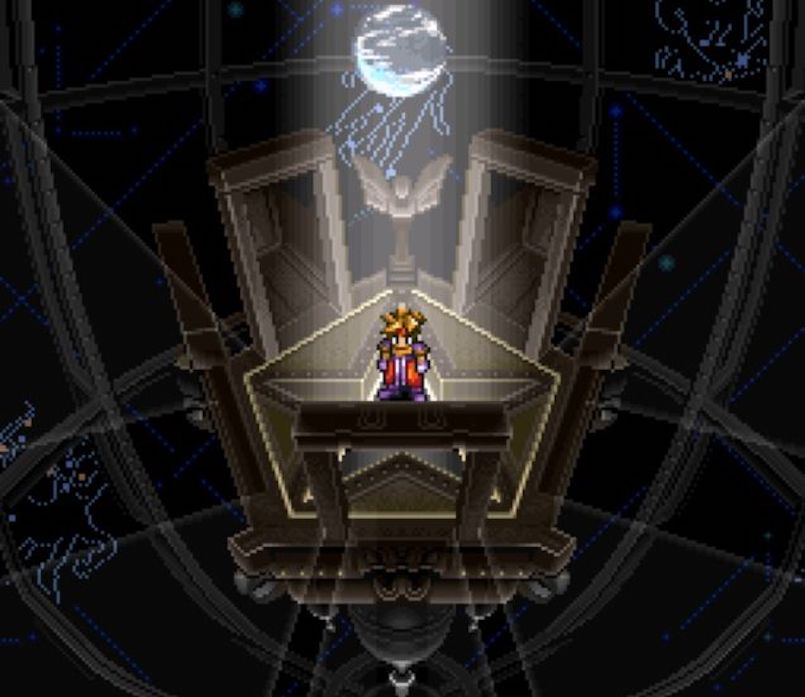
Terranigma is about the rebirth of the world and the follies of humanity. It’s also an existential probing into the quandaries of creation as Earth is being repopulated by your actions.
Traditional story arcs usually take place within three acts or as in Gustav Freytag’s theories, a five act drama. These arcs are more easily definable in films and books that follow the classical structure with the five parts being categorised as Exposition, Rising Action, Climax, Falling Action, and Dénouement. But games are harder to analyse and deconstruct, especially RPGs. Terranigma follows neither the 3 act nor the 5 act structure, but gives us 4 chapters and plays with the common tropes associated with RPGs in a fusing of religion, myth, and science fiction. At the same time, Terranigma’s ability to transcend the traditional structure and incorporate myth is part of what makes it so resonant. Let’s break it down.
-
Exposition (background information on characters and setting): The hero, Ark, is a troublesome kid living in an idyllic village that is the last bastion of life on the planet.
-
Rising Action (a series of events that spur the character into the conflict): Through a mix of curiosity and defiance, he accidentally causes everyone in his town to freeze and has to rescue them by reviving the continents of Earth.
The Conflict is where things get interesting. In most RPGs, there’s a very clear conflict and villain; Golbez in FFIV, Kefka in FFVI, Mother Brain in Phantasy Star II, Dark Sol in Shining in the Darkness and Shining Force, Lavos in Chrono Trigger, and so on. In the first two chapters of Terranigma, the conflict seems like it’s less about a traditional villain, and more a story about creation and resurrecting life. Ark rescues the gigantic tree, Ra, from parasites, helping plants to repopulate Earth. Birds and animal life follow, with the culmination being the rebirth of human civilisation. The Elder, who acts as a guide and father-figure to Ark, issues orders. Ark in turn follows without question, and overall, the trend is a positive one as evolution takes its guided course.
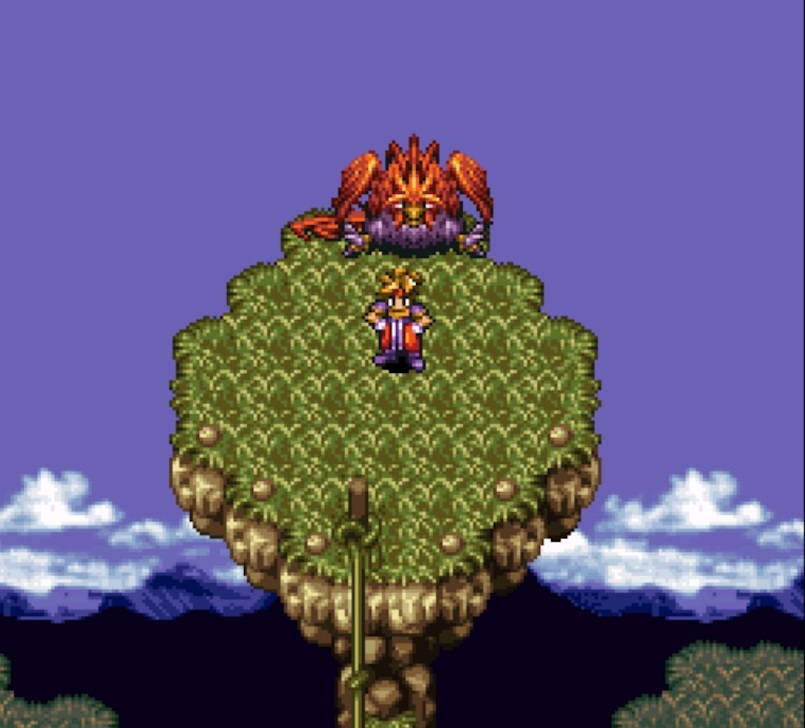
In the third chapter, human society is flourishing. Even without a villain, humans wreak plenty of destruction on themselves. There is a disturbing prevalence of death, pogrom, and tragedy. Human nature is the apparent villain. The quest here is to find “geniuses” who will help humanity advance, including personages embodied by NPCs like Eddy (Thomas Edison) or Bell (Alexander Bell). And that’s when we find the traditional structure can’t fully encompass the complexities of Terranigma because the conflict isn’t as straightforward. Instead, we have to turn to the Monomyth, or Hero’s Journey theory, as described by Joseph Campbell, which tries to find patterns in narratives throughout history. If we frame the Monomyth within the four chapters, we can better understand why Terranigma’s narrative is so compelling.
The Hero’s Journey
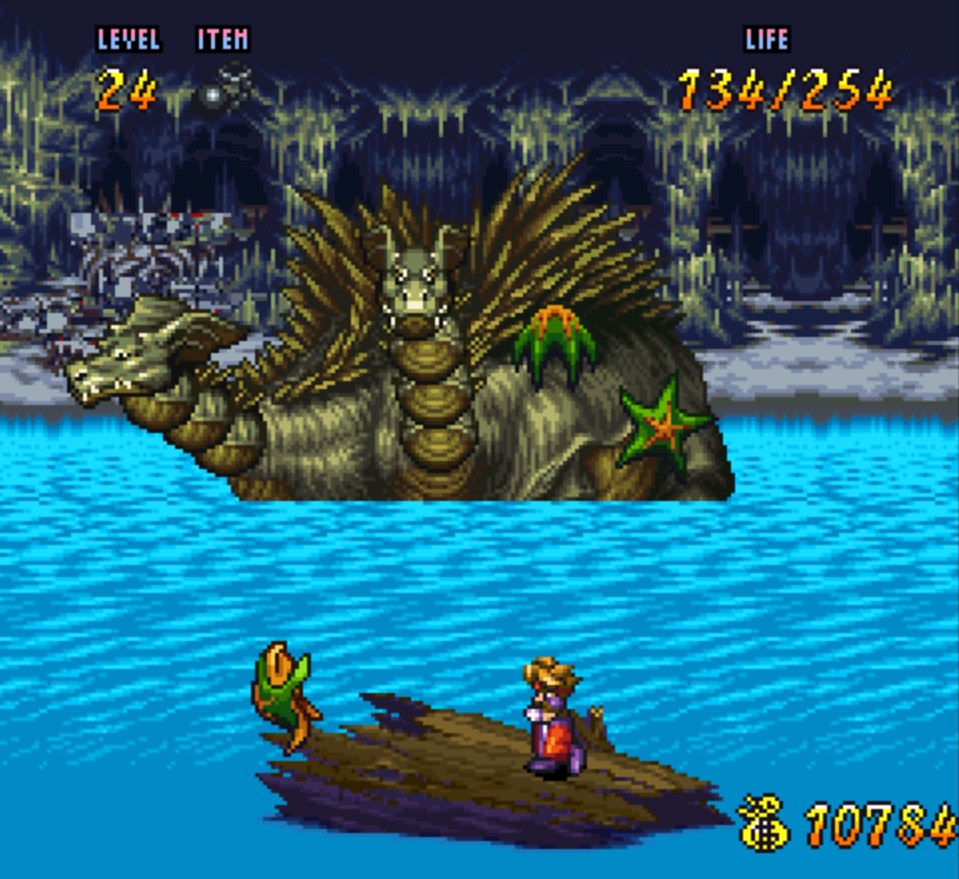
There’s 17 stages that Campbell describes in the Hero’s Journey and while a given myth doesn’t require all 17, the best often do. It’s surprising, then, how much the Monomyth aligns with Terranigma’s story. Take for example the first leg of the Hero’s Journey which Campbell calls the Separation where the Hero is separated from his home or state of repose, forced or choosing to take action that embark him on his journey. That, in conjunction with the Call to Adventure in Terranigma coincides with the Exposition and Rising Action (Arks set out to save the world after he opens the box that freezes his city). The Refusal of the Call, usually spurred by insecurities or obligations, is when the protagonist tries to deflect undertaking the great task placed before him (think Luke Skywalker at first refusing to go with Obi-Wan citing his responsibilities). This doesn’t happen in Terranigma because as Campbell explains: “For those who have not refused the call, the first encounter of the hero journey is with a protective figure (often a little old crone or old man) who provides the adventurer with amulets against the dragon forces he is about to pass. What such a figure represents is the benign, protecting power of destiny.” That figure is the Elder and Ark acts as a blunt weapon for his directives, slashing his way through his designated foes.
What does happen is a stage called Crossing the Threshold (a literal and physical space from which the hero can never return), represented when Ark jumps into a big gaping portal that takes him to the upper world, our Earth. There are also many Whale Bellies (a reference to the Biblical Jonah) that cause Ark to metamorphose in a “safe place,” whether in a physical sense, as he grows more powerful, or his own awareness of who he really is.
We can get back again to the Conflict which coincides with the second leg of the Monomyth, but this time, with the Road of Trials category to help us navigate. This is because there isn’t just one Conflict, but many on the “road” to becoming a hero, from helping the various villages to grow, to rescuing a tortured Christopher Columbus, and defeating sea monsters who are persecuting mermaids. Along the way, other elements of the Hero’s Journey are seamlessly blended in, as in a Meeting With the Goddess, described as an unconditional love, which is the upper world’s version of the woman Ark loved, Elle. In a twist, her life has been torn by tragedy and the trauma of her suffering has forced her to become mute. Ark helps her to deal with her pain, and their relationship evolves slowly throughout the game.
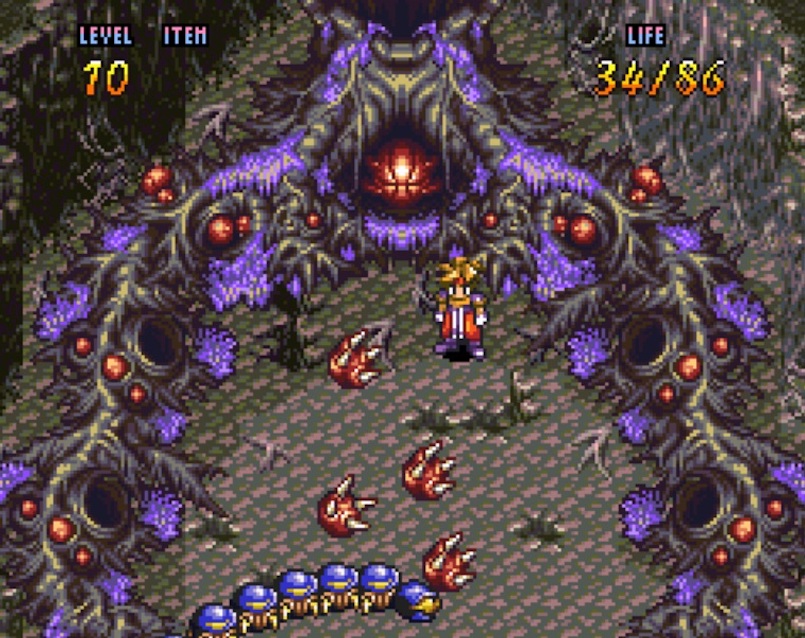
There’s even an odd take on the Temptress stage (a test that distracts the protagonist from their principal mission) with a young girl named Meilin who can conjure illusions and at the same time, falls in love with Ark herself. One of the most critical stages Campbell details, Atonement with the Father, has many manifestations: “The problem of the hero going to meet the father is to open his soul beyond terror to such a degree that he will be ripe to understand how the sickening and insane tragedies of this vast and ruthless cosmos are completely validated in the majesty of Being. The hero transcends life with its peculiar blind spot and for a moment rises to a glimpse of the source. He beholds the face of the father, understands — and the two are atoned.”
Ark doesn’t have parents and the closest thing to one is the previously mentioned Elder. But when he discovers the Elder is essentially the devil, the player is forced to ask, is atonement even a possibility when he’s perpetrated so much evil? The horrors of his own actions shock Ark, who doesn’t know or understand why he followed the commands so blindly. Adding to Ark’s woes, the Elder wants to replace him with a substitute son in the form of Beruga. Beruga’s vision of immortalizing humans as zombies means he wants to infect the majority of people with a virus called Asmodeus that obliterates its victims into light. He only wants to leave behind those who are “necessary,” a merciless cleansing that arbitrarily creates a world order of undead and dead.
Just when we, as gamers, assume we know where the plot is going (you know, stop the bad guy’s crazy plot and save the world), Beruga is killed in an accident when the fan in his airship sucks him in. As Fyda, one of Ark’s compatriots, muses at the tragic irony, “So Beruga gets killed by a machine he made… The greatest genius in history ends like that. Such is life…” Then, it’s the Elder’s turn to get his comeuppance. Although he created Arc specifically for his own purpose, which was to take over the world, in the final battle, his own creation destroys him. Even Quintet, the developers of the game who make an easter egg appearance, are swept away by the Asmodeus virus when all of Neo-Tokio gets destroyed.
All these conflicts foreshadow Ark’s own end. After he saves the world he created, he’s told by Light Gaia that the whole world of Dark Gaia and everyone in it will disappear, including him. His resurrection and Apotheosis are short-lived, even though as Yomi points out, “You’re what humans would call a god.” His path is wrought with tragedy and many friends sacrifice themselves so he can achieve his goal, as in the dark world Elle who loses her life while fighting to make sure baby Ark can survive.
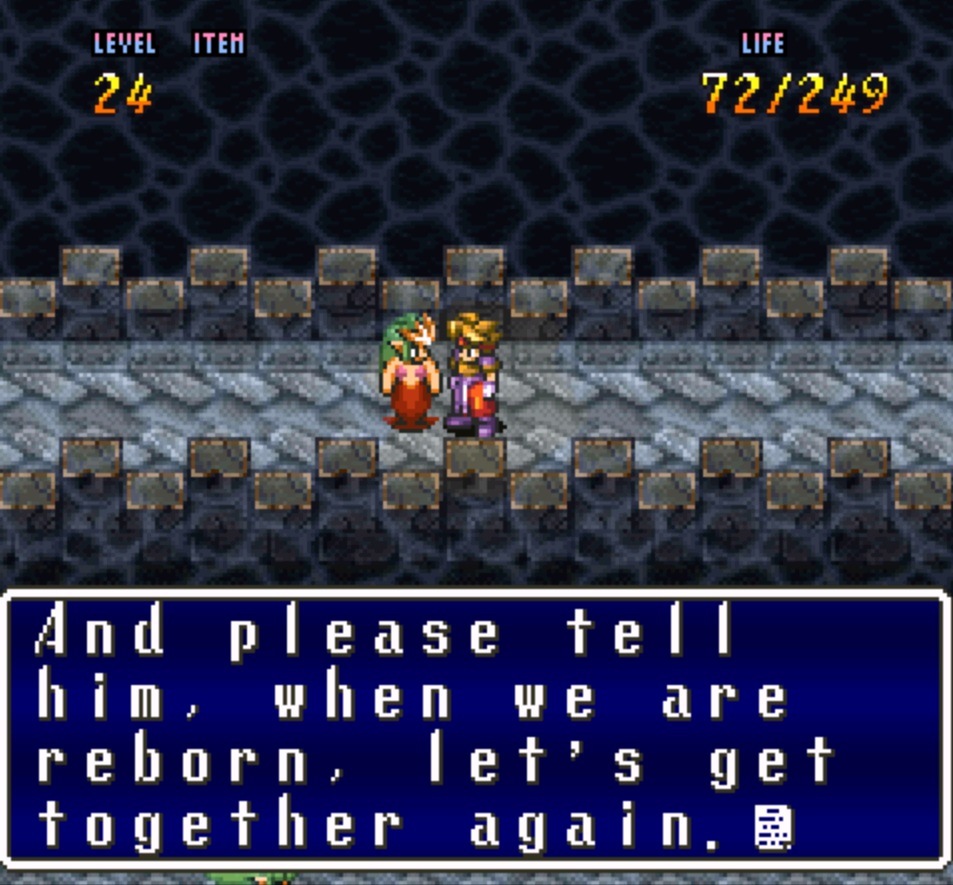
The interweaving of these complex themes is a huge part of what makes Terranigma so distinctive. It’s not just your typical “save the world” scenario. Ark’s character arc transcends a personal quest into one that resonates as a classic motif in myths throughout time- only in death is there life. The ancient gods have to die to make way for the new ones, as in the God of War series, Wagner’s The Ring of the Nibelung, and Stephen Donaldson’s Gap Cycle. But there’s also a warning against exploiting creation for personal gain, as in the case of the Elder who misused Ark for his own purposes. The secondary theme of protecting nature and the environment, a stewardship of sorts, is an important one, as evidenced by the relationships Ark forms with animals.
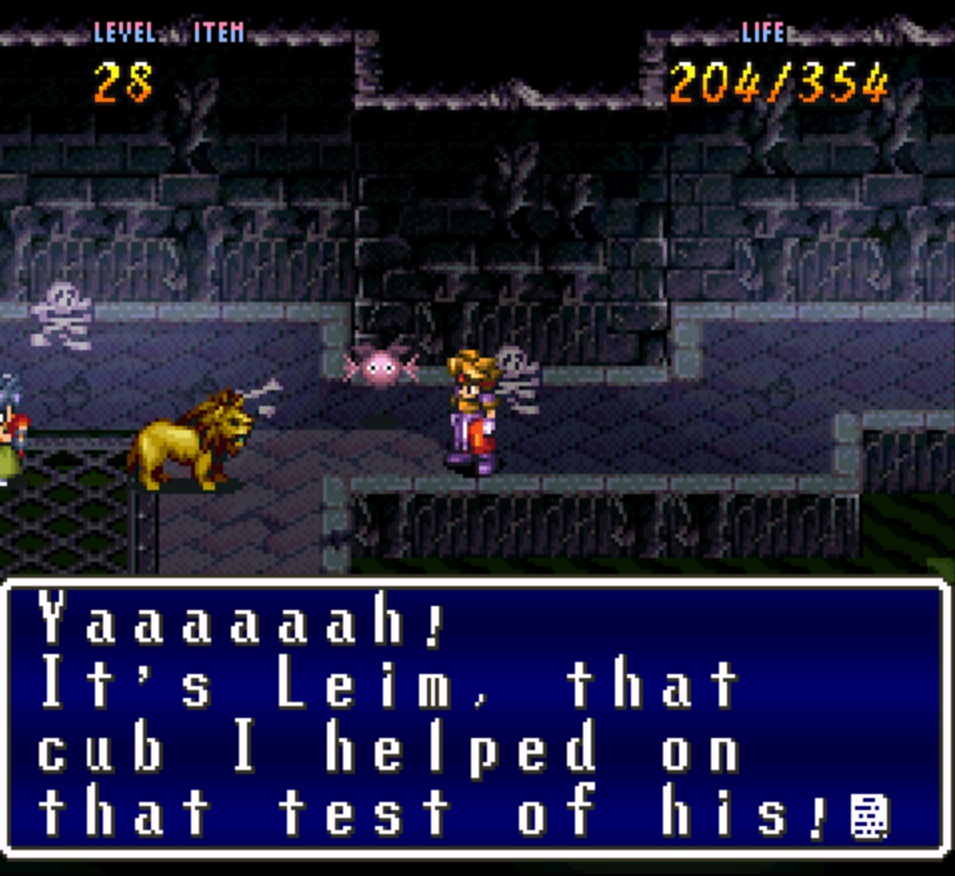
I actually missed talking to Terranigma’s lion king, Leim. The message is also incorporated into the gameplay mechanic of the limited magirocks which are the only way to earn and use magic. There’s a finite limit, a natural resource which, if used, are permanently gone. Ark is not omnipotent. Even he is bound by the laws of the world he helped create.
Dénouement
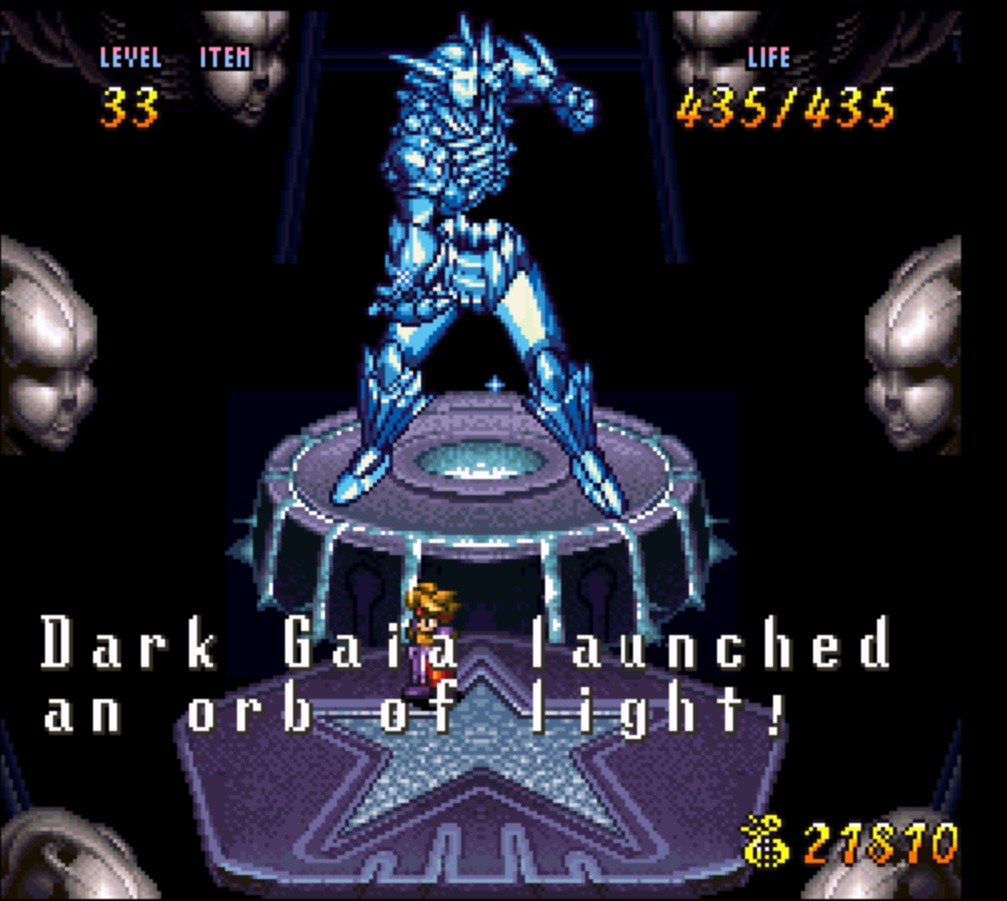
When the hero’s journey is completed, there’s usually a sense of satisfaction and joy at emerging victorious. Instead, Ark wonders if he would have been better off not even opening the box and bringing all the pain he does, including the death of the woman he loved. It’s in this context that Light Gaia gives Ark a final day to freely roam Crysta before he will die.
That last day is bittersweet. It’s not just Ark that’s changed, but you, as the player. Knowing the game will end, the symbolic death of Ark also represents the end of your time in Terranigma. After the long journey, a mix of nostalgia and longing filled me as I went from villager to villager. They talked to me as though nothing had happened and everything was back to normal. I felt old, like my innocence had been shattered. In the same way, Ark returns to the Elder’s room and reflects on when he first met the old man and how much he’d changed since then.
The final credits represent Ark’s last dream. He becomes a bird and soars through Earth, looking at the civilisation he helped create. Cities are populous at night, trains shuttle across the continent, and space ships are beginning to explore the stars. It’s a beautiful climax that represents the final stages of the Hero’s Journey; Master of Two Worlds (Light and Dark) and Freedom to Live where you are willing to give up your life for the world, no longer afraid of death. Ark’s impending demise doesn’t fill us with regret, but hope, because the civilisation will go on despite your death and flourish. Terranigma lives on in our imaginations.
The Chorus
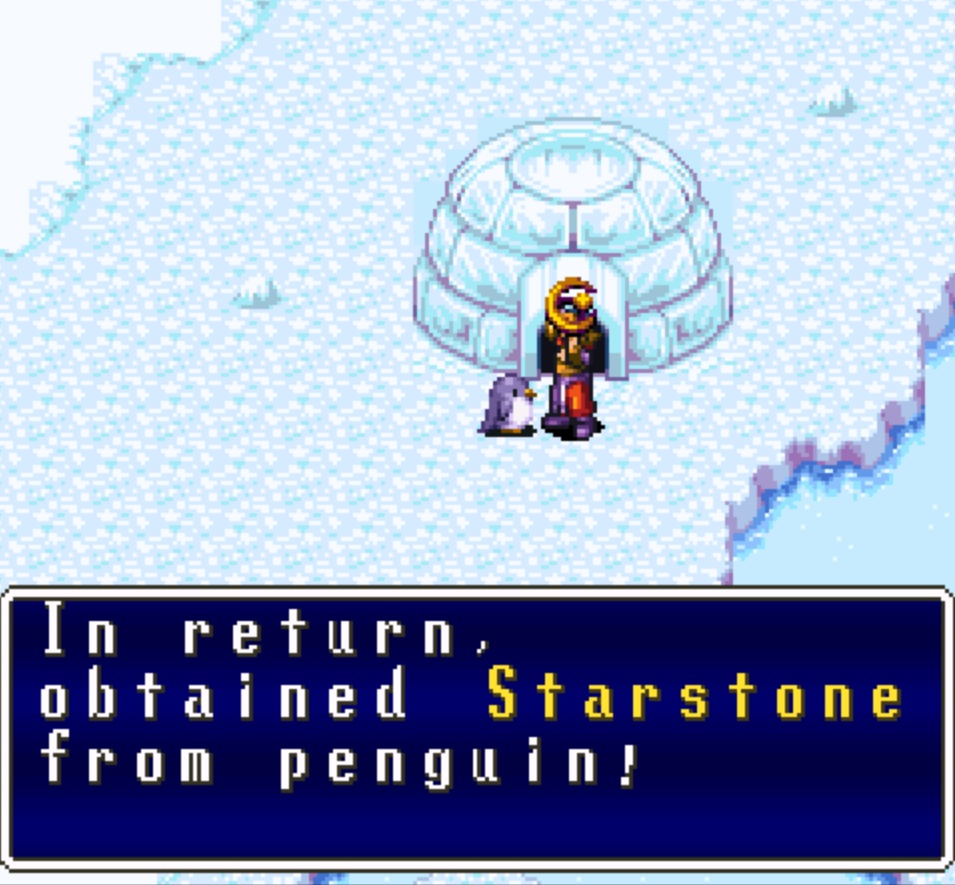
Terranigma’s music excels in the way it complements the gameplay and narrative. There are both conscious motivations and subconscious desires driving the protagonist. In the classical Greek Chorus, one of their jobs was to let audiences know about those hidden motives and thoughts. In Terranigma, the two composers, Miyoko Takaoka and Masanori Hikichi, help shape the atmosphere, forming “a tapestry and a language that speaks just as powerfully as the story.” They create the subconscious backdrop to this strange world and flesh out the characters. From the aforementioned Fyda’s theme, who’s willing to do whatever it takes to protect lightworld Elle because of a promise she made to her parents, to a flamboyant and bombastic Royd, the music tells us as much about the story as the dialogue. Framed within the game, the OST can embolden, excite, sadden, devastate, rejuvenate, and enlighten.
Terranigma’s combat system is exhilarating. Ark can jump, perform a spinning aerial attack in the air, rush thrust into foes, and even take a defensive stance via the R Button. Pressing the attack button repeatedly also unleashes a volley of quick thrusts that is deadly for foes. The battle animation is superb and the boss fights are complex enough where it requires players utilise their skills in different ways.
The variety of the levels makes them the perfect playground for Ark’s suite of moves. From the gigantic Ra Tree infected by a poisonous parasite, to the dessicated Zue that undergoes massive terraforming with rain, and even the underground towers with their shrines to creation, every area feels distinctive, posing a whole new suite of trials. The dungeons are physically transformed by Ark’s actions, peeling away the layers and opening new ground.
One of the most haunting areas is Bloody Mary’s castle, which has the creepiest paintings I’ve seen in a SNES era game with all the portraits missing their eyes. The first time I fought her, I was completely overpowered. My hits inflicted a paltry 1-3 damage compared to the usual 30-40 on other bosses. The most disturbing part of the battle was learning how the death of her three children drove her into madness. I felt guilty fighting her.
The End?
The final scene in Terranigma takes us to a house and we hear knocking. Light Elle answers it, wondering who it is. As she exits the door, the screen fades to a “The End.” It’s ambiguous, melancholy, and perfect. Has Ark been reincarnated? Will he end up with Elle and get the peace he deserves? A huge part of why Terranigma resonates so much with gamers is how much it syncs with the Hero’s Journey in the art style, gameplay, and narrative. This is a story anyone, regardless of their background, can appreciate.
In the end, I’d like to believe Ark went back to what was most important to him and found meaning in that. The true enigma of Terranigma isn’t just the fate of the planet, not even that of Ark, but us, the humans who survive and move on.
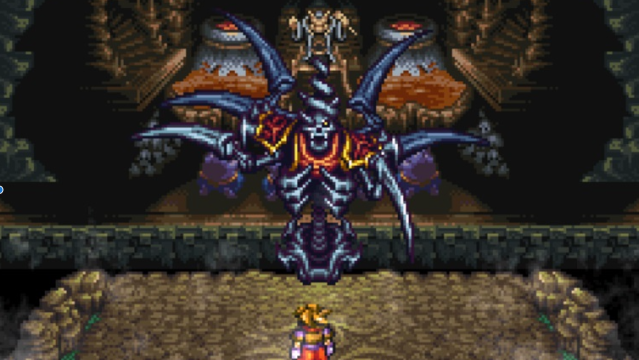
Leave a Reply